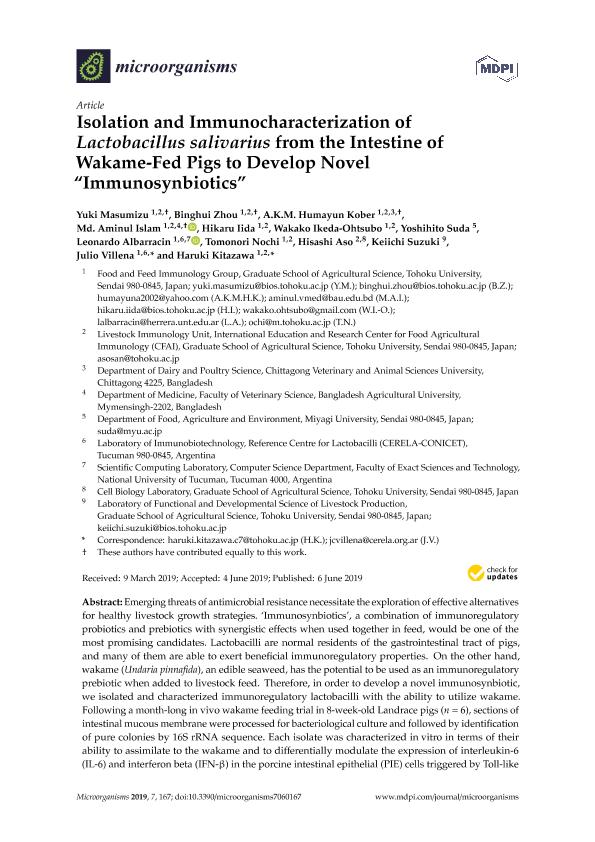Mostrar el registro sencillo del ítem
dc.contributor.author
Masumizu, Yuki
dc.contributor.author
Zhou, Binghui
dc.contributor.author
Humayun Kober, AKM
dc.contributor.author
Islam, M. Aminul
dc.contributor.author
Iida, Hikaru
dc.contributor.author
Ikeda-Ohtsubo, Wakako
dc.contributor.author
Suda, Yoshihito
dc.contributor.author
Albarracín, Leonardo
dc.contributor.author
Nochi, Tomonori
dc.contributor.author
Aso, Hisashi
dc.contributor.author
Suzuki, Keiichi
dc.contributor.author
Villena, Julio Cesar

dc.contributor.author
Kitazawa, Haruki
dc.date.available
2020-02-11T18:04:08Z
dc.date.issued
2019-06
dc.identifier.citation
Masumizu, Yuki; Zhou, Binghui; Humayun Kober, AKM; Islam, M. Aminul; Iida, Hikaru; et al.; Isolation and immunocharacterization of lactobacillus salivarius from the intestine of wakame-fed pigs to develop novel "Immunosynbiotics"; MDPI; Microorganisms; 7; 167; 6-2019; 1-17
dc.identifier.issn
2076-2607
dc.identifier.uri
http://hdl.handle.net/11336/97177
dc.description.abstract
Emerging threats of antimicrobial resistance necessitate the exploration of effective alternatives for healthy livestock growth strategies. ?Immunosynbiotics?, a combination of immunoregulatory probiotics and prebiotics with synergistic effects when used together in feed, would be one of the most promising candidates. Lactobacilli are normal residents of the gastrointestinal tract of pigs, and many of them are able to exert beneficial immunoregulatory properties. On the other hand, wakame (Undaria pinnafida), an edible seaweed, has the potential to be used as an immunoregulatory prebiotic when added to livestock feed. Therefore, in order to develop a novel immunosynbiotic, we isolated and characterized immunoregulatory lactobacilli with the ability to utilize wakame. Following a month-long in vivo wakame feeding trial in 8-week-old Landrace pigs (n = 6), sections of intestinal mucous membrane were processed for bacteriological culture and followed by identification of pure colonies by 16S rRNA sequence. Each isolate was characterized in vitro in terms of their ability to assimilate to the wakame and to differentially modulate the expression of interleukin-6 (IL-6) and interferon beta (IFN-β) in the porcine intestinal epithelial (PIE) cells triggered by Toll-like receptor (TLR)-4 and TLR-3 activation, respectively. We demonstrated that feeding wakame to pigs significantly increased the lactobacilli population in the small intestine. We established a wakame-component adjusted culture media that allowed the isolation and characterization of a total of 128 Lactobacilli salivarius colonies from the gut of wakame-fed pigs. Interestingly, several L. salivarius isolates showed both high wakame assimilation ability and immunomodulatory capacities. Among the wakame assimilating isolates, L. salivarius FFIG71 showed a significantly higher capacity to upregulate the IL-6 expression, and L. salivarius FFIG131 showed significantly higher capacity to upregulate the IFN-β expression; these could be used as immunobiotic strains in combination with wakame for the development of novel immunologically active feeds for pigs.
dc.format
application/pdf
dc.language.iso
eng
dc.publisher
MDPI
dc.rights
info:eu-repo/semantics/openAccess
dc.rights.uri
https://creativecommons.org/licenses/by-nc-sa/2.5/ar/
dc.subject
WAKAME
dc.subject
GUT MICROBIOTA
dc.subject
LACTOBACILLUS SALIVARIUS
dc.subject
PIGS
dc.subject
IMMUNITY
dc.subject.classification
Biología Celular, Microbiología

dc.subject.classification
Ciencias Biológicas

dc.subject.classification
CIENCIAS NATURALES Y EXACTAS

dc.subject.classification
Bioproductos, Biomateriales, Bioplásticos, Biocombustibles, Bioderivados, etc.

dc.subject.classification
Biotecnología Industrial

dc.subject.classification
INGENIERÍAS Y TECNOLOGÍAS

dc.title
Isolation and immunocharacterization of lactobacillus salivarius from the intestine of wakame-fed pigs to develop novel "Immunosynbiotics"
dc.type
info:eu-repo/semantics/article
dc.type
info:ar-repo/semantics/artículo
dc.type
info:eu-repo/semantics/publishedVersion
dc.date.updated
2019-12-11T20:20:54Z
dc.identifier.eissn
2076-2607
dc.journal.volume
7
dc.journal.number
167
dc.journal.pagination
1-17
dc.journal.pais
Suiza

dc.journal.ciudad
Basel
dc.description.fil
Fil: Masumizu, Yuki. Tohoku University; Japón
dc.description.fil
Fil: Zhou, Binghui. Tohoku University; Japón
dc.description.fil
Fil: Humayun Kober, AKM. Tohoku University; Japón. Chittagong Veterinary and Animal Sciences University; Bangladesh
dc.description.fil
Fil: Islam, M. Aminul. Agricultural University; Bangladesh. Tohoku University; Japón
dc.description.fil
Fil: Iida, Hikaru. Tohoku University; Japón
dc.description.fil
Fil: Ikeda-Ohtsubo, Wakako. Tohoku University; Japón
dc.description.fil
Fil: Suda, Yoshihito. Department Of Food Agriculture, Miyagi University; Japón
dc.description.fil
Fil: Albarracín, Leonardo. Consejo Nacional de Investigaciones Científicas y Técnicas. Centro Científico Tecnológico Conicet - Tucumán. Centro de Referencia para Lactobacilos; Argentina. Tohoku University; Japón. Universidad Nacional de Tucumán; Argentina
dc.description.fil
Fil: Nochi, Tomonori. Tohoku University; Japón
dc.description.fil
Fil: Aso, Hisashi. Tohoku University; Japón
dc.description.fil
Fil: Suzuki, Keiichi. Tohoku University; Japón
dc.description.fil
Fil: Villena, Julio Cesar. Consejo Nacional de Investigaciones Científicas y Técnicas. Centro Científico Tecnológico Conicet - Tucumán. Centro de Referencia para Lactobacilos; Argentina. Tohoku University; Japón
dc.description.fil
Fil: Kitazawa, Haruki. Tohoku University; Japón
dc.journal.title
Microorganisms
dc.relation.alternativeid
info:eu-repo/semantics/altIdentifier/doi/http://dx.doi.org/10.3390/microorganisms7060167
dc.relation.alternativeid
info:eu-repo/semantics/altIdentifier/url/https://www.mdpi.com/2076-2607/7/6/167
Archivos asociados
